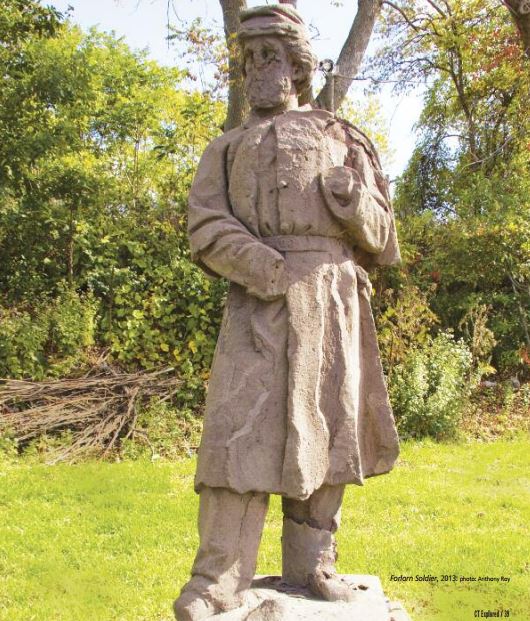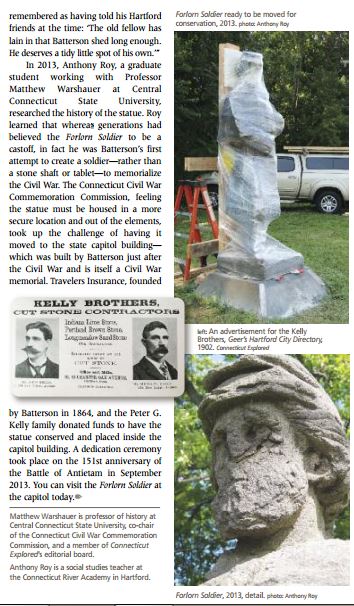By Anthony Roy and Matthew Warshauer
(c) Connecticut Explored Inc. SUMMER 2015
Subscribe/Buy the Issue!
 The c. 1860s Forlorn Soldier is a weather-beaten brownstone statue depicting a Union soldier. Much of the statue’s bearded face is gone, and his hands are missing. The remains of his bayonet and scabbard are fastened to his waist belt; the remnants of a rifle butt are between his feet. For years he stood, truly forlorn, by the side of Airport Road in Hartford. Yet he is a unique representative of both Hartford and Connecticut, their connection to the Civil War and especially the Battle of Antietam, and to one of the city’s and nation’s most prominent businessmen, James G. Batterson, the founder of Travelers Insurance and builder of monuments, including the state capitol. [For more about Connecticut in the Civil War, see the Spring 2011 and Winter 2012/2013 issues.]
The c. 1860s Forlorn Soldier is a weather-beaten brownstone statue depicting a Union soldier. Much of the statue’s bearded face is gone, and his hands are missing. The remains of his bayonet and scabbard are fastened to his waist belt; the remnants of a rifle butt are between his feet. For years he stood, truly forlorn, by the side of Airport Road in Hartford. Yet he is a unique representative of both Hartford and Connecticut, their connection to the Civil War and especially the Battle of Antietam, and to one of the city’s and nation’s most prominent businessmen, James G. Batterson, the founder of Travelers Insurance and builder of monuments, including the state capitol. [For more about Connecticut in the Civil War, see the Spring 2011 and Winter 2012/2013 issues.]
The Forlorn Soldier once stood outside a stoneyard in the Coltsville section of Hartford, but when that business was sold in 1968 he was moved to a small plot of land owned by the Peter G. Kelly family. Michael and John Kelly had purchased Batterson’s work yard, located at 93 Charter Oak Avenue, in 1895, establishing Kelly Brothers, Cut-Stone Contractors. The Hartford Courant reported that “the Batterson firm quit the stonecutting business, and the Kelly Brothers acquired the statue along with other unsold or incomplete works” and noted that “Michael Kelly is remembered as having told his Hartford friends at the time: ‘The old fellow has lain in that Batterson shed long enough. He deserves a tidy little spot of his own.’”
In 2013, Anthony Roy, a graduate student working with Professor Matthew Warshauer at Central Connecticut State University, researched the history of the statue. Roy learned that whereas generations had believed the Forlorn Soldier to be a castoff, in fact he was Batterson’s first attempt to create a soldier—rather than a stone shaft or tablet—to memorialize the Civil War. The Connecticut Civil War Commemoration Commission, feeling the statue must be housed in a more secure location and out of the elements, took up the challenge of having it moved to the state capitol building—which was built by Batterson just after the Civil War and is itself a Civil War memorial. Travelers Insurance, founded by Batterson in 1864, and the Peter G. Kelly family donated funds to have the statue conserved and placed inside the capitol building. A dedication ceremony took place on the 151st anniversary of the Battle of Antietam in September 2013. You can visit the Forlorn Soldier there today.
Explore!
Read all of our stories about Connecticut in the Civil War on our TOPICS page and in the Spring 2011 and Winter 2012-2013 issues.
Read all of our stories about Connecticut’s art history on our TOPICS page
